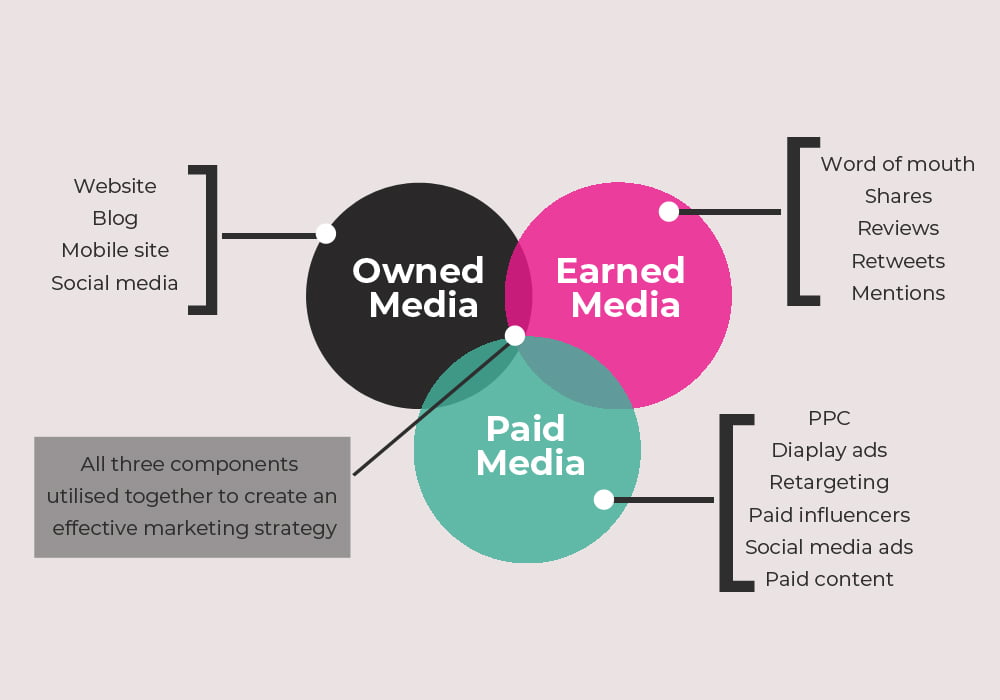Unless you’ve been living under a rock for the past decade or so, you know that social media is an incredibly important (if not fundamentally essential) tool in your marketing arsenal. However, the more you investigate, the more you begin to realize just how complicated social media marketing really is.
How to Balance a Paid, Owned, and Earned Social Media Strategy
Before deciding to invest in social media there are many legitimate questions that need to be answered. Where should I invest the bulk of my spend? What tangible results can I expect to see from these efforts? What does success even look like?
Luckily there exists a framework for looking at social media marketing that provides a way to easily divide and conquer different aspects of social media and allow you to better evaluate the entire enterprise as a singular whole.
Paid, Owned, and Earned
This framework is commonly referred to as the “paid, owned, earned” approach. The idea is essentially that all marketing falls into three different categories.
First there is the media that you pay for. This is traditional advertisements and promotions. Then there is media that you own – think blog content, visuals and other offerings that you or your team will create.
And finally, there is the Holy Grail of marketing– earned media. This is the fabled word-of-mouth that everyone is always talking about. This is where fortunes are made, and (specifically in social media) how things go viral.
Everyone would love to have the majority of their marketing be focused on earned media. After all, it’s the most effective and once you earn it, it’s the gift that keeps on giving. However, you actually have to “earn” this marketing and that takes a lot of work, especially when first starting out.
A much more realistic, practical, and sustainable strategy is to leverage all three types of media to work towards the goal of ultimately earning a strong social media reputation. This article will show you how owned and paid media can be leveraged to systematically build online goodwill and reputation.
Owned Media = Content Marketing
I know that this article is focused on social media marketing, but truthfully it is impossible to have a social presence without a strong focus on content. Whether your focus is on content creation or content curation, I’d argue that both fall underneath the umbrella of owned media.
Owned media is so important for social media because without doing or collecting things worth talking about, brands just end up talking about themselves. Not only does nobody listen to, or interact with shameless self-promoters, it actually turns users off to your brand.
Focusing on building out quality content of your own, and then supplementing this with well-curated ancillary content can serve as the basis for an engaging social presence.
A delightfully self-referential example of the value that quality owned content can contribute to a brand’s online presence is Quicksprout’s ADVANCED GUIDE TO CONTENT MARKETING. This high-quality, brand-appropriate content was published years ago yet still is shared regularly on social media.
Taking a look at Neil Patel’s (Quicksprout’s founder) Twitter shows a healthy mix of this sort of original content alongside a finely tuned and curated smattering of relevant content hand-picked from various trusted sources.
This strategy has two key benefits. First and foremost, no matter what the core focus is delivering high-quality and useful content to your followers. Doing so does wonders for building up your “earned” social reputation.
Secondly (and more subtly) listing your own content amongst other top-trusted sources will cause those who engage with and follow your brand to associate your content with that of other top industry players.
The combination of these two effects will slowly but surely allow your owned media to work towards developing a robust earned reputation on social media. This might sound great, but you might be wondering, how do I make sure my owned content actually reaches anyone? More importantly, how do I get people to start paying attention in the first place?
Use Paid Media to Supercharge Organic Distribution
My blog contributor Jacob Pastrovich recently wrote a GREAT PIECE detailing just how bad organic (i.e. non-paid) posts do on Facebook. According to his analysis, a non-paid Facebook post got “served to no more than 200 of our [18,000] fans….a meager 1%.”
Even for a page with roughly 18,000 users this is incredibly harmful, but for brands just starting out on social, 1% might be as few as 10-15 people. Even the most loyal dozen fans still can’t save a social strategy.
While the situation is particularly bad on Facebook, analyses show that things are only marginally better on other social sites. Barring some runaway viral success (don’t count on that) the only reliable way to get your social page of the ground is to turn to paid media.
Most social networks offer some sort of paid promotional option. However, in my experience the best offering by far is Facebook’s. Perhaps the best reason for this is Facebook’s feature that they call “Lookalike Audiences.”
What this truly remarkable product allows you to do is to advertise your posts to a completely new, yet algorithmically similar cohort. In plain English, Facebook essentially takes your audience and examines them using millions of data points from their “social graph” and builds a corresponding lookalike audience to serve your ads to.
A unique demonstration of the power of Facebook’s algorithmic guessing is highlighted in a fascinating TED Talk given by Jennifer Golbeck titled The Curly Fry Conundrum: Why Social Media Likes Say More Than You Might Think.
The title of the talk derives from the strange fact that one of the pages liked by users shown to be the strongest indicators of a high-intelligence individual is not something like MIT or The New Yorker; rather, it’s something as innocuous as Curly Fries.
What’s going on here? Essentially, such a broad and robust social network gives rise to strange network affects that (when examined objectively) lead to some counter-intuitive insights. Facebook’s lookalike audience technology leverages their data’s uncanny ability to find similarities in personality to expand the reach of your posts to those most likely to respond to them.
This means all you have to do in the beginning is focus on building out the best possible content for your audience and budget enough to promote your content out to your existing and lookalike audiences. Each time you do so, you’re on the path to slowly building an engaged following and spending less on your marketing in the long run as compared to traditional advertising.
Fostering An Earned Reputation
There’s a well-known economic effect called the PARETO PRINCIPLE. Explained broadly, this principle states that for any given effect 80% of the effects comes from 20% of the causes. The Pareto principle is a very useful way to understand the way that earned reputation is built and sustained on social media.
When it comes to your earned reputation on social media, it is highly likely that 80% of your likes, shares, re-tweets, etc… will be generated by 20% of your fan-base. The best (if not the only) way to manage, maintain and grow your earned media on social is to foster the growth of these 20% and do everything in your power to promote these healthy sharing actions.
As you begin to get into the groove of creating and curating valuable owned content and then using paid media to expand that content’s reach and influence, you should also always constantly be monitoring user response to this content and attempt to identify potential members of the 20%.
Make use of EFFECTIVE SOCIAL LISTENING to determine any users that are particularly active and interested in the topics you are posting great content about and make sure to acknowledge them publicly and often. Oftentimes, being engaging is as simple as saying “we see you and we’re listening.” For the power-user, this kind of validation can mean a great deal and might prompt them to join your team.
Building a dedicated audience of valuable allies is the real secret to earned social media success. Earned media is the most valuable kind, especially in regards to social. Use paid and owned media as strategic avenues for arriving at a self-sustained and well-earned social media reputation.








Leave a Comment
You must be logged in to post a comment.